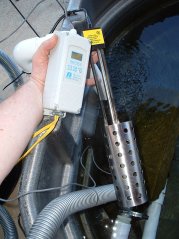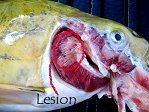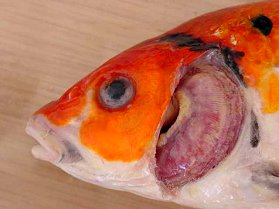Overview:
Koi are generally hardy fish. They’re descended from the common carp and are tough, essentially omnivorous fish with the ability to withstand a range of living conditions.
As an ornamental specimen, the Koi is beautiful, and sought after for it’s highly strained color varieties.
Koi health and disease is essentially a balancing act or “equilibrium” created between stocking density, water-and-environmental conditions, parasites, and the fish itself.
It was once said that “if you take care of the environment, the fish will take care of themselves”. This was true until some of these viruses started showing up with increasing regularity.
Introduction to the Viruses:
There are (at least) two known viruses of importance to Koi. There are other viruses but these are important from the perspective that they can quickly kill the fish and are both highly contagious.
- SVC / Spring Viremia of Carp (Rhabdovirus carpio)
- KHV / Koi Herpes Virus
These viruses are similar and dissimilar. Some of their differences and similarities are important.
Koi Herpes Virus – Spring Viremia of Carp – What You Should Know*
Recently Discovered?
No. This virus was described in the literature more than forty years ago.
No. KHV was reported in Japan fully ten years before it’s first outbreak or discovery in Israel. The earliest documentation I can find is from the 1980’s
Kills Fish?
SVC has recently been shown to kill groups of fish when experimentally injected with the virus, earlier researchers maintained that the SVC only allows opportunistic bacterial infections which then can kill the fish. Mortalities may be 20-30% if supportive care is given and the environment is optimized.
KHV kills upwards of 70%-90% of exposed fish which have not been previously exposed to KHV.
Seasonal
SVC Yes – Spring
KHV Yes – Spring and Fall
Endemic (native) to the USA?
Yes and No: The ‘party line’ is that the virus had not formerly been found in North America but there is emerging evidence that the virus was indeed being encountered in fish kills in Wisconsin almost a decade ago.
Reported “absence” of SVC from American waters may have been due to a lack of testing. I personally (ELJ) think that SVC is an endemic, and highly morbid contributor to many of the Springtime die-offs and illnesses we’ve seen every year for the past two decades.
The problem is that testing for SVC can result in quarantine or worse. Retailers are unlikely to “step up to the plate” and endeavor to discover this virus and limit its distribution.
Doubtful.
Koi Herpes Virus
This KHV virus seems to be infecting “groups” of exposed fish which go on to infect others, or simply die off en masse. It’s own virulence (aggressiveness) is probably limiting it’s morbidity.
Lesions: Pale white lesions may result due to the co-infection by bacteria. Fish may develop a pink or red color in the skin as infection progresses. Yes. Pale white lesions may appear in the gills of affected fish. Excess slime, especially on the head and nape of the fish seems common. Body-color of the fish may become blotchy and the internal organs may be damaged or even liquefied.
Diagnostic Challenges
People don’t want to submit for, nor do some labs want to test for; SVC because of the maelstrom it causes. SVC is an RNA virus and requires an extra step when using PCR technology to diagnose it. When the virus is not in a vulnerable host or is not in its ideal temperature range for replication, it’s diagnosis is essentially impossible. The PCR test and the other culture and swabbing techniques available are quite accurate for infected fish but false negatives can occur. When the virus is not in a vulnerable host or is not in its ideal temperature range for replication, it’s diagnosis is essentially impossible. Diagnosing “occult” (hidden) carrier-states of KHV may be impossible with current technology.
Immune Carrier States?
Fish usually survive SVC; but their carrier state is unconfirmed.
Survivors of KHV are said to be clear of the virus and cannot be re infected with KHV.
The lack of virus in post-infection specimens is probably due to the difficulty in detecting virus in asymptomatic fish or fish outside the viruses’ ideal range.
Kind of Virus
SVC: RNA virus, rhabdo (bullet) shaped.
KHV: DNA virus. (Herpes virus)
Testing
Can be cultured, there is a reverse PCR test for this virus. Can be cultured, can be detected via novel nucleic acid tests (swabs), can be detected by PCR testing.
Reportability
This morbid SVC virus is reportable by law.
This KHV highly virulent virus is ALSO legally reportable but is as yet unregulated.
Prevention
SVC Prevent exposure to the virus.
KHV Prevent exposure to the virus.
Control – Treatment
SVC: If fish are supported in ideal environments and secondary infections are controlled through aggressive antimicrobial therapy, including antimicrobial food and injections, 70+ percent survival is possible.

KHV: Mortalities may be kept below 70% if the fish are rapidly warmed to above 80 Degrees Fahrenheit.
To put the brakes on a late-summer outbreak, you can let the temperature sail down into the forties instead of heating, and the losses will slow down as the virus is deprived of it’s ideal temperature range. Fish may still die from prior damage done by the virus.
Sooner or later, the fish will have to be warmed up.
During an outbreak; if possible you can move the fish as quickly as possible to temperatures higher than 80 oF, or lower than the seventies (in Fo)
Spring Viremia:
The real issues concerning SVC are it’s status as a reportable virus. It’s very possible that many breeder and wholesale facilities (as well as many residential ponds) have fish which harbor this virus. Testing is currently possible, but is not being undertaken on a widespread basis, because of the cost, the lack of centralized and unified regulation, and a reluctance of civilians, and researchers to open that “can of worms”. Retailers concerned that their stocks could harbor this virus would put themselves out of business by soliciting SVC testing by a laboratory and receiving a positive result *.
Fortunately, SVC isn’t a terribly efficient killer of fish and could be considered ‘mild’ at least compared to KHV. Well-cared-for fish can often survive the virus not unlike the way healthy people survive the Influenza virus, and optimally housed fish may not even break out with signs of infection.
I for one do not spend much time worrying about the SVC condition because I would neither subject my customers to diagnosis (and potential persecution caused by an SVC diagnosis), nor would it change my treatment, which is antimicrobial support “past” the ravages of the virus . I am, as a healthcare provider to fish, almost alone with this opinion *.
KHV:

The real issues concerning KHV is it’s predilection for a narrow temperature range for infection, and it’s ability to hide when it’s outside those temperatures in asymptomatic (not sick) fish. If you grind up a healthy-looking fish which you think might have or be carrying KHV looking for virus, you can easily miss the diagnosis unless the fish is actually viremic. When a fish is symptomatic and sick with a KHV infection, the virus can usually be cultured into certain cell lines, detected by enzyme linked PCR tests, or even detected by unique nucleic acids in it’s structure.
What it boils down to is this:
If you’re considering buying some nice new fish this Spring, how do you know the fish isn’t just sitting there; ready to explode with KHV as soon as it hits seventy degrees Fahrenheit?
You don’t have any security unless the fish has been through the following cycle of cold-then-warm, which are believed to be important triggering events for KHV infections:
- Stress
- Cold water,
- Warming, to the viruses ideal range in the seventies (oF) allowing virus to replicate and damage the fish.
So, a fish which has endured, and survived, a temperate (North American) climate change from winter to summer could be regarded as the safest fish to buy but does not rule out that the fish could be carrying the virus. Some dealers are artificially inducing these cold-then-warm cyclic changes in their recent imports (unnecessarily, all it needs is 74 oF) to try and bring these cases out of the woodwork before sale by chilling and then warming the fish after importation, creating a “mini” cycle.
Testing for KHV can prove the fish to be without the virus and “not currently infected” but since the carrier state is a relative “unknown” at the present time, there is little security in a negative KHV test in a healthy fish. A negative KHV test in sick fish could be considered much more reliable as most fish with active infections have virus which is capable of detection by available means.
Quarantine will become a necessity, not an ideal, in 2003. This quarantine could arguably be 8-12 months to allow a complete “cold-warm-cold” cycle in order to reveal occult KHV or SVC infections.
An actual case:
KHV Strategy
The following was used on one of several cases of KHV which broke out in the Fall of 2002. The fish were being heated despite the onset of wintertime temperatures outside, to support the fight against what appeared to be a severe bacterial infection. Then an Arkansas laboratory indicated it was KHV. We had stopped the losses initially with Tricide Neo but the losses resumed a week after the Tricide dipping which made us even more suspicious that we were dealing with a virus. (In quotes, my customer communication)
“Your losses have not been on par with the others, most folks lose 70-90% of their fish in a week or two. This is not a cause for optimism. It may be because you used the Tricide-Neo it could also be because temps were falling as they broke….
However, now most of the fish *are* symptomatic and as the Arkansas specialist indicated, you COULD let the heat off and the virus COULD (should?) go dormant.
In the Spring, here’s the possibility: Since most of the fish are showing signs, it’s safe to say they are “viremic”. If they are chilled ***RIGHT NOW*** (today!) – could they not chill down, stop the virus / viremia / replication, and with warming in the Spring, perhaps mount an immune response???
Yes, it’s possible. Researchers I spoke to know that we cannot re infect KHV survivors. Did they survive the KHV with natural immunity or luck?; or do they develop specific immunity afterward, from incomplete (non-terminal) infection???
So, here’s my recommendations for Winter KHV Outbreaks:
1) STOP HEATING NOW if the fish have KHV.
2) STOP the water falls; to prevent the phenomena of “supercooling” from chilling them too fast.
3) Maintain mid-water circulation to maintain aeration and to de-gas the pond.
4) Remove dead as they show up.
5) In the Spring – when the Arkansas specialist , you, and I have talked, we should “accelerate” the heating process. *NOT* letting them warm up slowly, naturally.
We should do a sort of: “On your mark, get set, go!” and move them as quickly and safely as possible through the warming process, for example, when water naturally hits 45-47 oF we could suddenly take them “5-degrees-per-day” to a whopping, most “KHV-unfriendly” eighty oF Six day warm up. Window in the seventies: TWO
Crazy? Maybe. Kill all your fish? Not like the virus probably would if water temperatures were suspended in the seventies..
Finally, you *do* see the problem with complete disinfection, “depop-repop” plans. If you sacrifice all your remaining fish, to get new healthy ones; what on earth will prevent you from restocking with 49 healthy fish and ONE MORE KHV carrier? Nothing.
So I am not really in favor of a wholesale depopulation at this time.
Best regards
Erik Johnson DVM
Outcomes: When the pond was cooled, the losses basically stopped. The fish became lethargic and went to the bottom. A few of the worst fish which were about to die when the water was warmer continued to become sicker and died.
Some other fish were brought inside and rapidly warmed to 80 oF, and made remarkable recoveries. Spring 2003 is not here as of this writing but there is some encouragement that if rapidly warmed, these fish may recover.
Post Script:
It bears mentioning that it is the professional opinion of most researchers and ornamental fish health specialists in this field, that in the interest of the health of our nation’s Koi and carp livestock, all individuals and retailers suspecting that their fish might be infected with SVC or KHV should request testing for these infectious agents.
My (ELJ) position has been to recommend that retailers and wholesalers decline SVC testing and to destroy fish which might be infected. This represents irresponsible behavior on the part of the dealer and puts the hobby at risk because it will hamper attempts to detect and eliminate the SVC virus. However, the position is a result of the following:
Currently, if your fish are diagnosed with SVC you will be summarily bankrupted by the following processes currently in place:
There is (in fact) financial compensation for lost livestock which may be tested and slaughtered. Requests to operate under a new business name with new broodstock and new production ponds will probably be (and have been) denied.
The problem with the financial remuneration policy is that there is NO MONEY allocated in ANY fiscal budget to make the promised payment.
No official process exists to formally determine the length of impound and quarantine. You may be under quarantine for an indefinite period of time.
There are no mechanisms to protect your identity and you may be informed of your SVC infection along with the rest of the industry, simultaneously.
There is no standard format, nor standard interval for testing of your peers or competitors, so you may be the only organization subjected to the penalties associated with reportable SVC infections.
*Errors or omissions in the above are possible but are unintentional. Some of the above is based on hearsay, opinion or verbal exchanges with researchers in the field. Newer information may be available.






